Lifestyle
Bearing witness, celebrating strength: How poetry has changed lives for NPR's audience

The last photo Trisha Fountain took with her mother in May, 2006. Fountain’s mom died the week after her graduation. She said the poem “Epitaph” has helped offered her comfort.
Trisha Fountain
hide caption
toggle caption
Trisha Fountain

The last photo Trisha Fountain took with her mother in May, 2006. Fountain’s mom died the week after her graduation. She said the poem “Epitaph” has helped offered her comfort.
Trisha Fountain
Last month, we asked NPR readers what poetry means to them. We received nearly 500 responses, from lifelong poetry fans to those who have only recently come to enjoy the genre. From sparking the imagination to helping with mental health, listen to poems read by NPR readers and see how poetry has affected their lives.
Responses have been edited for length and clarity.
Poetry to heal from grief
Trisha Fountain reads “Epitaph”
Dozens of readers shared stories of how poetry helped them process grief. Trisha Fountain of Ann Arbor, Mich., lost her mother to cancer the week after she graduated from college. “The months that followed were filled with feelings of confusion, anger, sadness, emptiness and lack of purpose,” she said.
Six months later, Fountain spent her first birthday without her mother at the funeral of her friend’s mother, who died of the same cancer. She heard Merrit Malloy’s “Epitaph” read at this funeral. Now 40 years old, Fountain still remembers the poem. “This poem allowed me to feel seen, held, directed and connected to my mom in a way that my grief didn’t allow me to process before that moment,” she said. “Throughout the last few decades, I have shared that poem with countless others during the loss of their loved ones as a way to ‘pay it forward’ and attempt to gift others with the same comfort and life affirmation it gave to me.
Melissa McNabb reads “One Art”
Many readers shared their love for “One Art” by Elizabeth Bishop. Melissa McNabb of Michigan said it was the first poem that made her gasp aloud when reading it. Aerie Treska of Baltimore, Md., said the poem took her breath away, “both because of the rawness of the speaker’s grief and the poem’s deceptively simple, yet elegantly complex structure, rhythm, and diction.” Treska calls it a “master class in the power of poetry to bear witness.”
Poetry for mental health
Evan De Back reads “The Things I Didn’t Do”
For many readers, poetry has been a transformative force in their lives as they battle various mental health struggles.
“Poetry has been an outlet for my emotions in stressful times, most often while I was depressed,” said Evan De Back of Johnston City, Tenn. The 39-year-old sometimes feels like he can’t express himself to others because his emotions are too raw. “[Writing poetry] helps me process and move past emotions that would otherwise mire me in rumination.” De Back reads a poem he wrote called “The Things I Didn’t Do.”
Poetry to inspire confidence
Some readers said they always have a poem they reach for when they need a reminder of everything they are capable of achieving. “In poems, we readers see our mirrored reflection and gain new insight into ourselves,” Lara Cowell of Honolulu, Hawaii, said. Cowell read Kimberly Blaeser’s “About Standing (in Kinship), because of how it “celebrates our collective strength and power when we work in synergy, harmony and friendship.”
Evan Wang reads “Muse for Night”
Evan Wang of King of Prussia, Pa., said poetry helped both him and his community blossom. Once a self-described “timid student,” Wang now performs his poetry as a Youth Poet Laureate. “Poetry found me — a first-generation American living in the quiet suburbs — in this vastness, took my hand, and helped me find myself. He shares his poem, “Muse for Night.”
Poetry to rouse the imagination
Hayley Kelsey of Florida calls poetry the highest literary art. “It comes closer to rendering the world around us than any other,” she said. “It has opened my eyes and ears to the wonders of the world again and again: sound, images, perception.”
Many other readers agreed that poetry sparks their imagination and stimulates their senses. Coel Whitemab of Honolulu, Hawaii, believes “poems are for everyone and everything” because everyone will interpret a poem differently. “Poetry sets me free…to imagine my life as a bird soaring on the breeze of imagination and thoughtfulness,” he said.
Nina Laubach reads “Absence, Presence”
Nina Laubach of Lawrenceville, N.J., shares her favorite poem, “Absence, Presence,” by Luisa A. Igloria. “I love how this poem moves through time, seasons, and generations and also returns us to our present, daily mundane lives,” she said. “It is…as if imagination was not some alternate, secondary path, but rather the very essence of expressing the experience, memory and longing to be human.”

Lifestyle
The MacArthur Foundation wants bold solutions to big problems — the prize is $100M

In 2017, Sesame Workshop and the International Rescue Committee became the first winners of 100&Change for their work with children in the Middle East. Above, Elmo learns how to fly a kite at Azraq Camp, Jordan.
Ryan Donnell/Sesame Workshop
hide caption
toggle caption
Ryan Donnell/Sesame Workshop

In 2017, Sesame Workshop and the International Rescue Committee became the first winners of 100&Change for their work with children in the Middle East. Above, Elmo learns how to fly a kite at Azraq Camp, Jordan.
Ryan Donnell/Sesame Workshop
Any major challenge, in any field, anywhere in the world.
That’s what the MacArthur Foundation is looking to solve with its third round of 100&Change, a $100 million grant competition for proposals that tackle, it says, “one of the world’s most critical social challenges.”
Chris Cardona, managing director of Discovery, Exploration, and Programs at the foundation, said MacArthur hasn’t identified specific challenges it hopes grants will address. “It continues to be a global, athematic competition,” he said.

The MacArthur Foundation is soliciting bold ideas to solve one of the world’s biggest problems. The winning proposal will receive $100 million.
MacArthur Foundation
hide caption
toggle caption
MacArthur Foundation
Instead, the MacArthur Foundation, which also supports NPR, is looking for feasible, evidence-based proposals that provide a solution with deep impact and that have a clear explanation for how they will measure success.

Community Solutions received $100M from the MacArthur Foundation “to accelerate an end to homelessness in 75 communities.” Erica Holmes interacting with Community Solutions’ client Andrew Overby.
Community Solutions
hide caption
toggle caption
Community Solutions
The first two winners were a collaboration between Sesame Workshop and the International Rescue Committee for their work helping children affected by conflict and crisis in the Middle East, and Community Solutions for a program aiming to end homelessness in 75 U.S. communities within five years.
The finalists for the 100&Change competition will be announced in the spring of 2025.
This story was edited by Jennifer Vanasco.
Lifestyle
She turned an empty L.A. lot into a gorgeous mini flower farm as a 'win-win'

Kathleen Ferguson grabbed a pair of pruning shears from a mailbox nailed to a garden bed and leaned down to cut bunches of Orlaya grandiflora on the flower-filled hillside.
“This property has a pulse,” she said as she placed the white lace flowers into a bucket of water. “The wildlife is incredible here. I’ve caught bees napping in the sunflowers.”
With limited land for green space in Los Angeles, many people are growing flowers for sale in surprising places — under power lines and in their front and backyards. In Ferguson’s case, the landscape designer is propagating flowers on a vacant lot offered by a friend, screenwriter Dalan Musson, whom she met while volunteering at the North Central Animal Shelter in L.A.
The vacant hillside, before Kathleen Ferguson transformed it into a flower garden.
(Kathleen Ferguson)
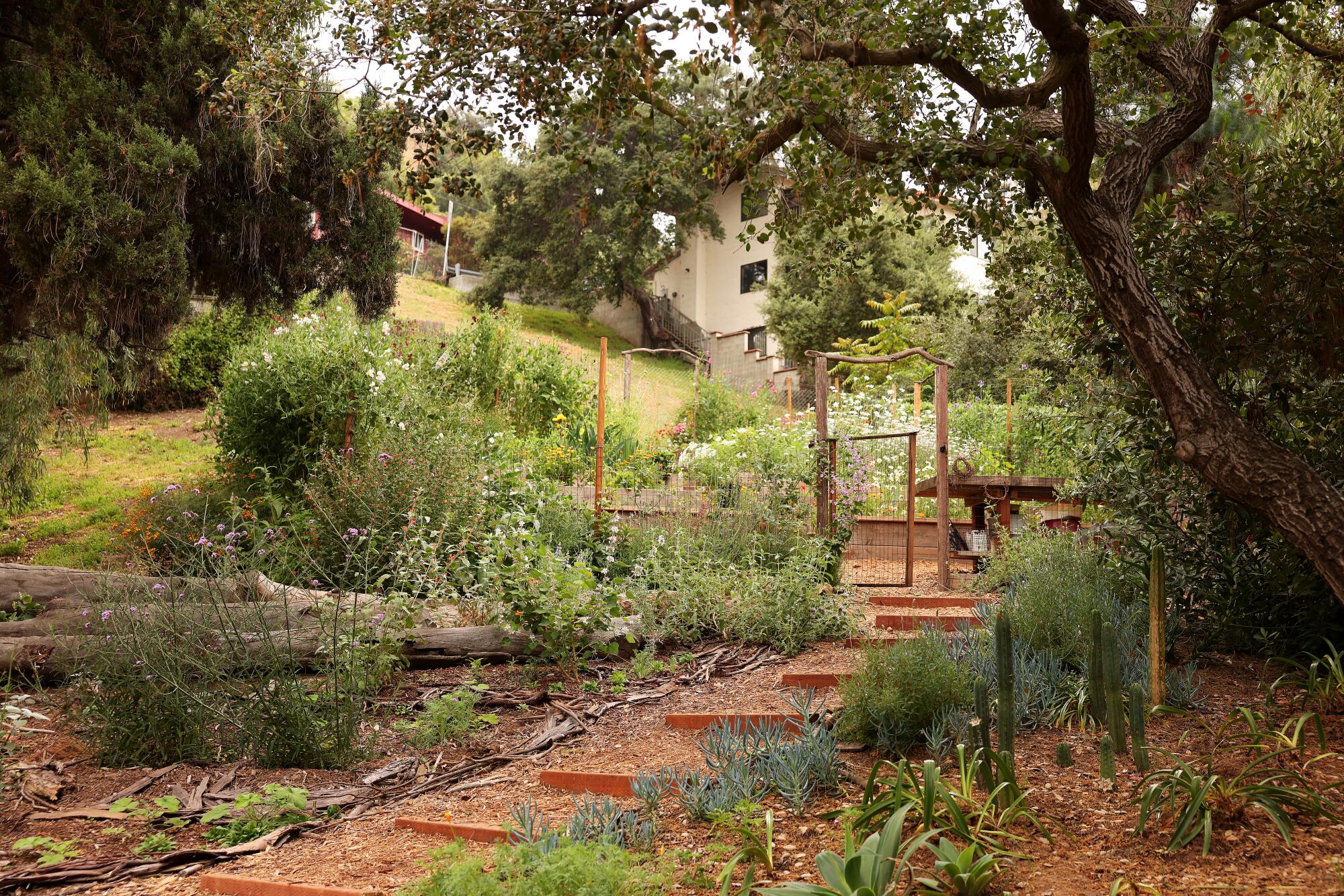
Ferguson’s lush garden now.
“Just being able to walk outside and see monarch butterflies and bees flying around my backyard is amazing,” Musson said of Frogtown Flora’s effect on the wildlife on his 1.5-acre property in Eagle Rock. “It makes me feel viscerally connected to the natural world.”
It’s magical for Ferguson too, who over the last 11 months has built a colorful farm on the half-acre with flowers, including Agrostemma, irises, zinnias, cosmos, roses, sunflowers, sweet peas, French dianthus and ranunculus. White marigolds and green onions are planted to help deter the skunks, raccoons and squirrels that like to pull out her dahlias. Volunteer tomatoes and cilantro that materialized from the compost are left to bolt and blossom. “I like to mix it up,” she said of the variety of plant life. “If something comes up, I’m OK with letting it grow.”
Outside the farm’s perimeter and at the top of the hillside, she is experimenting with drought-tolerant California native perennials, including fragrant pitcher sage, buckwheat, mallows and the native rose, Rosa Californica. She also grows native poppies — Matilija and California — penstemons, lupines and many different salvias.
Like many landscape designers used to working outdoors, Ferguson struggled with cabin fever during the COVID-19 pandemic. When she began listening to podcasts about locally grown blooms while tending to her own garden, she became “obsessed with flowers.”
“I would listen to podcasts all day long: ‘On Being,’ ‘Slow Flowers,’ ‘Cultivating Place’ and [‘Field & Garden’ from the Gardener’s Workshop] among them,” she said. She was struck by the environmental effect of imported flowers regarding pesticides, water and shipping, and her journey into urban flower farming was a natural progression. With a degree in horticulture from Cal Poly Pomona and a passion for the environment, she decided to grow what she describes as “climate-appropriate flower species” for Los Angeles.
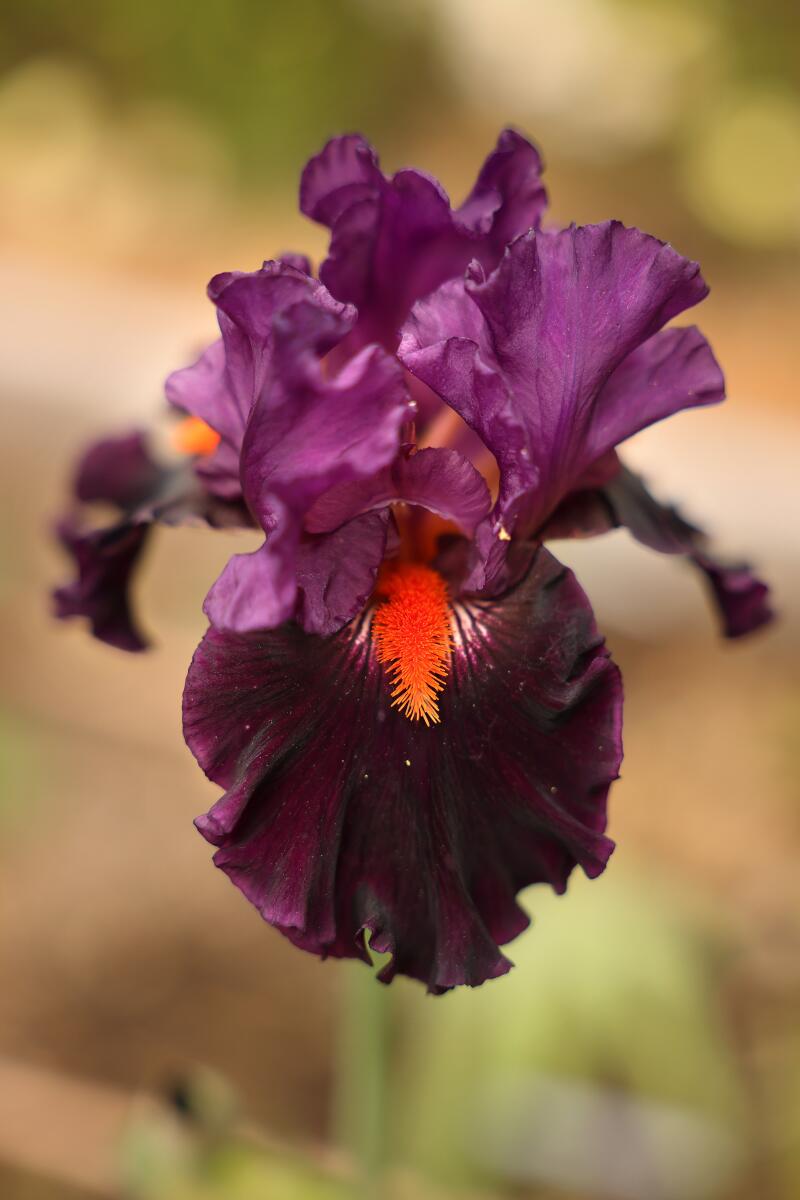
A Sharp Dressed Man iris in Ferguson’s garden.

Ferguson tends to her flowers.
She learned a lot from the local flower growers she contacted on Instagram: “I noticed that all of the flower farmers, who happened to be women, are so passionate about what they do and so generous with their knowledge. I can reach out to any of them and ask, ‘What has been your experience with germination?’”
The flower growers hosted rotating potlucks at their farms and attended the San Fernando Valley Iris Society, of which Ferguson is a member.
Her first venture was a small plot at Jardin del Rio on Riverdale Avenue in 2022. But as her interest and knowledge grew, so did her ambitions. When Musson listened to how passionate she was about growing flowers locally, he offered a portion of his property as a new canvas for her urban flower farm.
“People are good,” Ferguson said of Musson. “People are generous; they want to help others realize their dreams. It’s a win-win for both of us.”
The challenge for Ferguson was the site. “I was excited,” she recalled, “but when I saw it was a slope, I knew it would be a lot of work.”
Once she understood how it might work, she built 12 four- by 10-foot raised beds on either side of a stairway with wood leftover from a construction project.
“My husband and I loaded the wood in a truck and brought it here,” she said. “Now, when I get extra wood, I can’t help but think about what I can grow here. We’re going to put in a greenhouse and add more beds. Everyone my age is into pilates and strength training, and when they suggest I go, I tell them, ‘Do you know how much strength training I do on this slope?’”
Ferguson’s good luck continued when she realized the soil didn’t need a lot of work because the land had never been developed. “We used what was here,” said the designer and certified arborist, who avoids chemicals. She started with a weed barrier, on-site soil, worm castings, compost and organic fertilizer. She tops the soil with her rabbits’ bedding when it’s time for it to be replaced and has been experimenting with sheep pellets to enrich the soil and help deter slugs, snails and weeds. She installed a drip irrigation system and pays Musson monthly for water, although she said she doesn’t use it much. “The natives don’t require any once established,” she added.
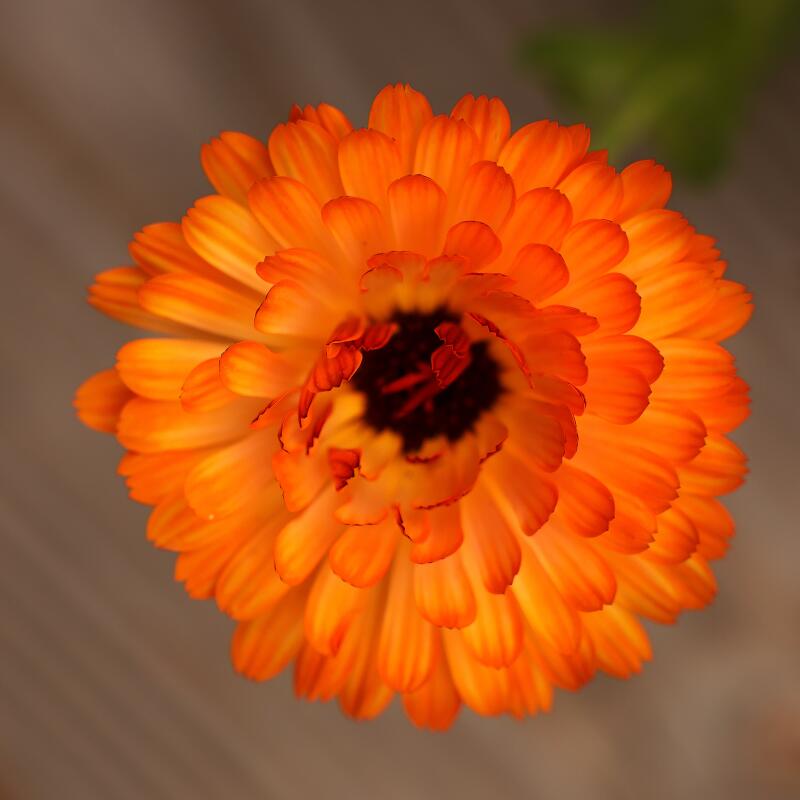
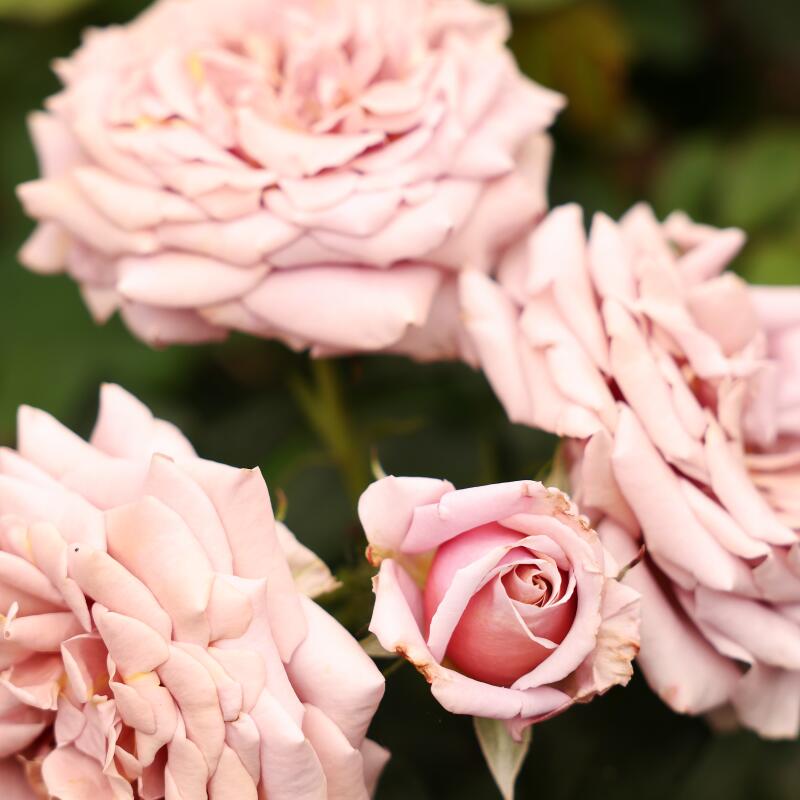

Calendula. Koko Loco roses. Penstemon.
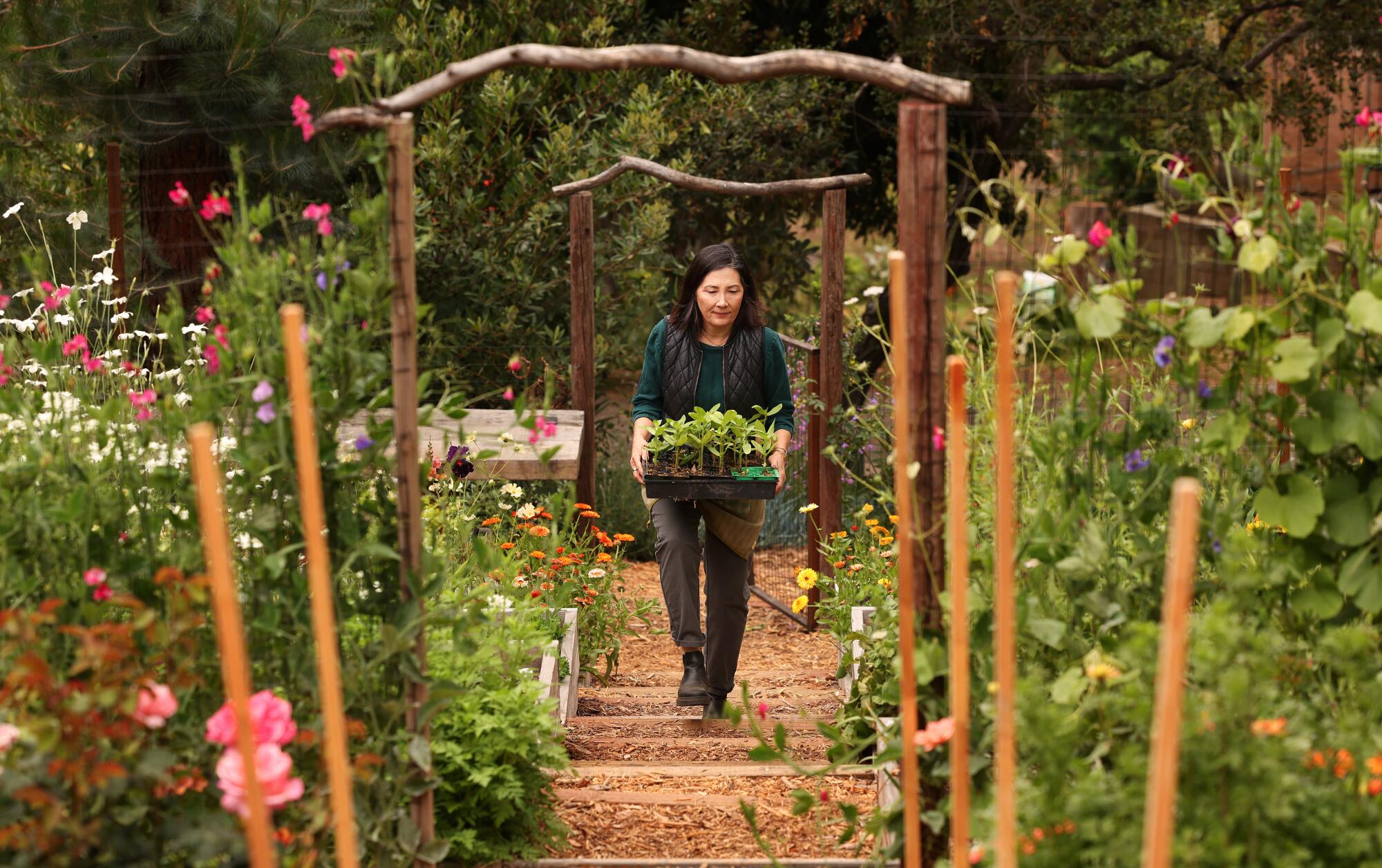
Ferguson carries zinnias she grew from seeds up the stairs of her hillside garden.
She is a big fan of using rabbit waste as fertilizer because it doesn’t require composting like chicken manure.
“Rabbit poop is amazing and so good if you are trying to close the loop in your garden,” she says, “as you can feed them a lot of greens, and then what they produce goes straight into the garden.”
While some farmers choose what is trendy, Ferguson prefers to plant flowers she likes. It’s a strategy that is working.
“Kathleen’s flowers are dazzling,” said Lauri Kranz, who sells Ferguson’s flowers at L.A. Homefarm in Highland Park. “When Kathleen pulls up in her car with buckets full of just cut flowers, our customers start making a line to pull from the bounty that awaits.”
For Ferguson, a Los Angeles native who grew up in Koreatown, flowers are about more than just beauty.
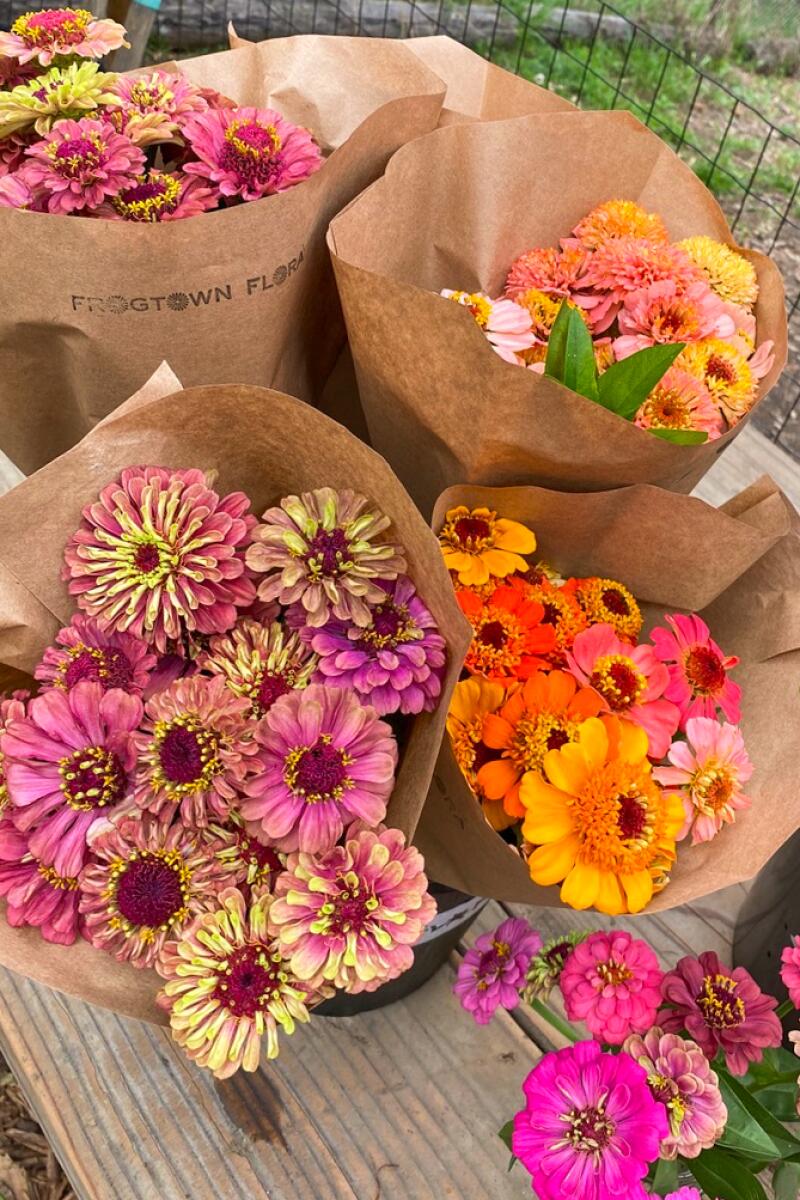
Frogtown Flora bouquets. (Kathleen Ferguson)

Zinnias in Ferguson’s garden. (Christina House / Los Angeles Times)
There’s the feel-good aspect. “It brings so much joy,” she said. “Flowers have been in our culture for as long as humanity. Flowers symbolize so many things. It’s the whole cycle of life. They mean so much to so many different cultures. I love growing. I love the challenge. I also love that I’m making people happy.”
And then there’s the wildlife aspect.
During a recent visit, the contrast between the roar of the nearby 2 Freeway and the sound of birds chatting in the garden was startling. Over in a dense patch of sweet peas, Ferguson pointed out an example of her “nature first” philosophy in the way she strategically cut the flowers to preserve the privacy of a bird’s nest. “The flowers have brought so much additional life to this property,” she said. “I leave that section of sweet peas alone.”
In addition to selling flowers to Kranz and Gather Flora at the Original Los Angeles Flower Market in downtown , Ferguson recently started bouquet subscriptions and organized a tour of eight flower farms in L.A. She expected 50 people to show up. “We had to shut down our reservations when it hit 800,” she said, noting the interest in locally grown flowers.
According to a 2023 National Gardening Assn. Survey, 63% of respondents indicated that locally grown blooms were important when purchasing cut flowers and arrangements, while 59% indicated that blossoms grown in the United States were important when purchasing cut flowers and arrangements.
Like the slow food and slow fashion movements, consumers want to know where their flowers come from, said Debra Prinzing, founder of the Slow Flowers Society.
“I think people want to engage more deeply with nature as an antidote to the general stress and chaos of life,” Prinzing said. “Locally grown flowers, like those from Frogtown Flora and other Southern California flower farmers large and small, provide the sensory connections we crave. They reflect the season, moment in time and location when we commemorate special occasions or everyday gestures.”

Dawn Creek Blush in Ferguson’s garden.

Ferguson smells a rose in her hillside garden.
Ferguson, 55, also sells mixed vase arrangements and buckets of blooms to customers interested in fresh flowers but not necessarily a designed arrangement. “This is a great option for DIY weddings and celebrations and for those who just want beautiful, pesticide-free, fresh and locally grown flowers,” she said.
Walking up to the garden from the street along the long driveway, it’s clear why Musson is delighted with the plot’s transformation.
“Some days, when I’m exhausted, I’ll come up here and see a new flower that I’ve never seen before,” he said. “Sometimes I can’t believe I’m living in L.A. A Target is within walking distance, yet I have mature coastal live oaks, toyon and Catalina cherry trees. There are bats. I hear owls at night…. It’s amazing to have a place for the bees and butterflies to go.”
Lifestyle
What's it like to live in a vacation spot when tourists leave? 'Wait' offers a window


Thomas Wolfe famously titled one of his novels You Can’t Go Home Again. It’s something to keep in mind when reading Gabriella Burnham’s Wait, in which a mother and daughter experience two very different homecomings after years away. Both come to see the birthplaces they left in their late teens in new light.
Burnham’s second novel is not the breezy beach read you might expect from its Nantucket setting and the classic shingle-style shorefront house on its cover. Instead of a summer frolic, what we have here is a coming-of-age story set against a backdrop of stark economic disparity. Wait features a less well-known Nantucket, a millionaires’ vacationland whose year-round residents, some of them undocumented, struggle to pay high rents and make ends meet, especially during the slack off-season when local service businesses like landscaping, housekeeping, and restaurants go on hiatus.
The novel begins on the eve of its main character’s graduation from college, where she’s majored in environmental studies. Due to financial constraints, Elise has not been back home to Nantucket since she left for North Carolina four years ago. She’s excited that her mother, Gilda, and her 18-year-old sister, Sophie, are coming to celebrate this milestone with her.
But after a night of partying on campus with her wealthy best friend, Elise awakens to alarming news from her sister: Their mother has gone missing. She never showed up for the ferry, the first stage of their long trip to Chapel Hill.
Gilda, who left Brazil more than two decades earlier, is a cook who puts in 70-hour weeks during Nantucket’s high season in order to support her two American-born daughters. The girls’ father, an Irish bartender whom Gilda met soon after her arrival on Nantucket, headed back to Ireland without a trace when the girls were young.
We soon learn that Gilda, who’d let her last visa lapse 18 years earlier during her rough second pregnancy, was intercepted on her way to the Hyannis ferry by ICE agents and deported, “subject to expedited removal.” An ICE official, it turns out, had been monitoring Gilda’s social media accounts, which tipped the agency off about her plans to leave the island in order to attend her daughter’s college graduation.
Gilda lands back in Brazil at her half-sister’s home, shaken and worried about her daughters. The girls field her frantic calls, often en route to their low-wage summer jobs. Whatever else one might say about Gilda, she has clearly done a good job raising her two daughters, who are excellent students and diligent workers. Sophie, just out of high school, takes on extra shifts at a local upscale café, where she remains unflappable in the face of demanding customers’ complicated orders for fancy coffees. Elise returns to her pre-college summer job monitoring endangered wildlife on a remote stretch of protected shoreline. Fledging plovers become a lovely symbol for how the resourceful women in this family take flight.
When Elise’s college friend Sheba arrives at the summer estate that her two high-powered, socially connected moms have recently inherited from her grandfather, it at first feels like an answered prayer to the sisters’ mounting housing worries.
In an interview with her publisher, Burnham spoke of her firsthand knowledge of housing insecurity on this island of multimillion dollar mansions that sit empty for most of the year: When she was in high school, her family was evicted from their rental home, and she and her sister were placed in foster care. Her mother, like Gilda, was from Brazil and worked in Nantucket kitchens, though she was not deported. Burnham’s familiarity with Brazil enriches both Wait and her first novel, It Is Wood, It Is Stone, about an anxious American woman’s relationship with her grounded Brazilian housekeeper when she moves to Sao Paulo for her husband’s job.
Set during a uniquely stressful summer for Gilda and her daughters, Wait highlights the strong bonds between the three of them. Burnham also probes various friendships, as well as relationships between summer residents and year-rounders on the island.
In contrast to the sisters, Sheba is a woefully unsympathetic character. Her role in the novel is to drive home the familiar point that material riches can be spiritually impoverishing and that financial security doesn’t protect against emotional insecurity. Sheba’s jealousy of Elise’s relationship with Sophie and her petulant sense of entitlement provide too sharp a contrast to the sisters’ caring connection and purposeful lives. It strains credulity that sensible Elise would be drawn to her for so long. Would she be if Sheba weren’t so rich? “Promise you love me for more my than my house?” Sheba says pathetically after she has behaved particularly obnoxiously.
Burnham’s assured narrative pulls us along, although some peculiar word choices give pause: “a cascade of pasta,” “the accomplishment” of Sheba’s mothers’ room, “a stroll of emotion loitering inside her.”
Yet, quibbles aside, Wait movingly tackles serious issues in one of America’s premier vacation spots. It is a commendable accomplishment.
-

 Education1 week ago
Education1 week agoVideo: Protesters Scuffle With Police During Pomona College Commencement
-

 World1 week ago
World1 week agoEU's divided right wing can disrupt if it finds greater unity: experts
-

 News1 week ago
News1 week agoStudent protests caused mostly minor disruptions at several graduation ceremonies
-

 News1 week ago
News1 week agoNevada Cross-Tabs: May 2024 Times/Siena Poll
-

 World1 week ago
World1 week agoPro-Palestinian university students in the Netherlands uphold protest
-

 Politics1 week ago
Politics1 week agoWhite House walks diplomatic tightrope on Israel amid contradictory messaging: 'You can't have it both ways'
-

 Politics1 week ago
Politics1 week agoDem newcomer aims for history with primary win over wealthy controversial congressman
-

 Politics7 days ago
Politics7 days agoSouthern border migrant encounters decrease slightly but gotaways still surge under Biden















